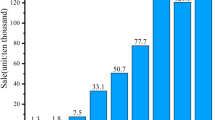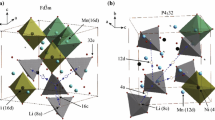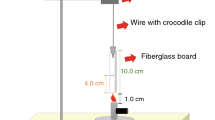Abstract
In the new energy vehicle field, the lithium ion batteries (LIBs) are widely used as energy storage devices. In this paper, the decay characteristics and thermal stability of LIBs’ negative electrode with capacity retention rate (CRR) 60–100% were studied. The lithium content and polarization impedance of the negative electrode were analyzed by constant current charge/discharge test, the inductively coupled plasma–optical emission spectrometer test and impedance test. The result reveals that the capacity loss caused by the active lithium loss mainly occurs before 80% CRR, and the deterioration of kinetic performance is the main reason for capacity loss of negative electrode with 80–60% CRR. Surface composition, structure changes, and thermal stability of the negative electrode were analyzed by scanning electron microscope, X-ray photoelectron spectroscopy, X-ray diffraction, and differential scanning calorimetry. The results show that the SEI film becomes more inorganic and its conductivity of lithium ions decreases as the capacity retention rate declines, which have an important effect on the kinetic performance of negative electrode. The thermal stability of the negative electrode also decreased significantly because of the loose secondary SEI film formation at elevated temperature.








Similar content being viewed by others
References
Wang J, Sun X (2015) Olivine LiFePO4: the remaining challenges for future energy storage. Energy Environ Sci 8:1110–1138
Wang J, Sun X (2012) Understanding and recent development of carbon coating onLiFePO4 cathode materials for lithium-ion batteries. Energy Environ Sci 5:5163–5185
Goodenough JB, Park KS (2013) The Li-ion rechargeable battery: a perspective. Am Chem J 135:1167–1176
Goodenough JB, Kim Y (2009) Challenges for rechargeable Li batteries. Chem Mater 22:587–603
Barré A, Deguilhem B, Grolleau S, Gérard M, Suard F, Riu D (2013) A review on lithium-ion battery ageing mechanisms and estimations for automotive applications. J Power Sources 241:680–689
Tan L, Zhang L, Sun Q, Zheng H (2013) Capacity loss induced by lithium deposition at graphite anode for LiFePO4/graphite cell cycling at different temperatures. Electrochim Acta 111:802–808
Guan T, Sun S, Gao Y, Du CP, Cui Y, Zhang L, Yin G (2016) The effect of elevated temperature on the accelerated aging of LiCoO2/mesocarbon microbeads batteries. Appl Energy 177:1–10
Li J, Zhang J, Zhang X, Yang XN, Xia B (2010) Study of the storage performance of a Li-ion cell at elevated temperature. Electrochim Acta 55:927–934
Safari M, Delacourt C (2011) Simulation-based analysis of aging phenomena in a commercial graphite/LiFePO4 cell. J Electrochem Soc 158:A1436–A1447
Li D, Danilov DL, Xie J, Raijmakers L, Gao L, Yang Y, Notten PHL (2016) Degradation mechanisms of C6/LiFePO4 batteries: experimental analyses of calendar aging. Electrochim Acta 190:1124–1133
Li D, Danilov DL, Gao L, Yang Y, Notten PHL (2016) Degradation mechanisms of C6/LiFePO4 batteries: experimental analyses of cycling-induced aging. Electrochim Acta 210:445–455
Kim JH, Woo SC (2013) Capacity fading mechanism of LiFePO4-based lithium secondary batteries for stationary energy storage. J. Power Sources 229:190–197
Sun S, Guan T (2018) Accelerated aging and degradation mechanism of LiFePO 4/graphite batteries cycled at high discharge rates. RSC Adv 8:25695–25703
Groot J, Swierczynski M, Stan AI, Kær SK (2015) On the complex ageing characteristics of high-power LiFePO4/graphite battery cells cycled with high charge and discharge currents. J. Power Sources 286:475–487
Darma MSD, Lang M, Kleiner K (2016) The influence of cycling temperature and cycling rate on the phase specific degradation of a positive electrode in lithium ion batteries: a post mortem analysis. J. Power Sources 327:714–725
Guo Z, Chen Z (2016) Aging property for LiFePO4/graphite cell with different temperature and DODs. Russ J Electrochem 52:546–554
Sarasketa-Zabala E, Gandiaga I, Martinez-Laserna E (2015) Cycle ageing analysis of a LiFePO4/graphite cell with dynamic model validations: Towards realistic lifetime predictions. J. Power Sources 275:573–587
Li D, Danilov DL, Gao L, Yang Y, Notten PHL (2016) Degradation mechanisms of the graphite electrode in C6/LiFePO4 batteries unraveled by a non-destructive approach. J Electrochem Soc 163:A3016–A3021
Li D, Danilov DL, Xie J, Raijmakers L, Gao L, Yang Y, Notten PHL (2016) Degradation mechanisms of C6/LiFePO4 batteries: experimental analyses of calendar aging. Electrochim Acta 190:1124–1133
Liu P, Wang J (2010) Aging mechanisms of LiFePO4 batteries deduced by electrochemical and structural analyses. J Electrochem Soc 157:A499–A507
Groot J (2014) State-of-health estimation of Li-ion batteries: ageing models, Chalmers University of Technology
Liu K, Liu Y, Lin D (2018) Materials for lithium-ion battery safety, Science advances 4 eaas9820
Wang Q, Ping P, Zhao X (2012) Thermal runaway caused fire and explosion of lithium ion battery, J. Power Sources 208:210–224
Liu X, Ren D, Hsu H, Feng X (2018) Thermal runaway of lithium-ion batteries without internal short circuit. Joule 2:2047–2064
Vortmann-Westhoven B, Winter M, Nowak S (2017) Where is the lithium? Quantitative determination of the lithium distribution in lithium ion battery cells: investigations on the influence of the temperature, the C-rate and the cell type. J Power Sources 346:63–70
Friesen A, Horsthemke F, Mönnighoff X (2016) Impact of cycling at low temperatures on the safety behavior of 18650-type lithium ion cells: combined study of mechanical and thermal abuse testing accompanied by post-mortem analysis. J Power Sources 334:1–11
Wu G, Chen M, Zhu G, You J, Lin Z, Zhang X (2003) Structural characterization and electrochemical lithium insertion properties of carbon nanotubes prepared by the catalytic decomposition of methane. J Solid State Electrochem 7:129–133
Kjell MH, Malmgren S, Ciosek K (2013) Comparing aging of graphite/LiFePO4 cells at 22 °C and 55 °C – electrochemical and photoelectron spectroscopy studies. J Power Sources 243:290–298
Dupre N, Martin RF, Degryse R (2010) Aging of the LiFePO4 positive electrode interface in electrolyte. J Power Sources 195:7415–7425
Verma P, Maire P, Novák P (2010) A review of the features and analyses of the solid electrolyte interphase in Li-ion batteries. Electrochim Acta 55:6332–6341
Tasaki SK (2005) Decompositions and physical properties of decomposition compounds in Li-ion battery electrolytes studied by DFT calculations and molecular dynamics simulations. J Phys Chem B 109:2920–2933
Aurbach D, Markovsky B, Weissman I (1999) On the correlation between surface chemistry and performance of graphite negative electrodes for Li ion batteries. Electrochim Acta 45:67–86
Dedryvère R, Gireaud L, Grugeon S (2005) Characterization of lithium alkyl carbonates by X-ray photoelectron spectroscopy: experimental and theoretical study. J Phys Chem B 109:15868–15875
Terborg L, Weber S, Blaske F, Passerini S, Winter M, Karst U, Nowak S (2013) Investigation of thermal aging and hydrolysis mechanisms in commercial lithium ion battery electrolyte. J Power Sources 242:832–837
Agubra VA, Fergus JW (2014) The formation and stability of the solid electrolyte interface on the graphite anode. J Power Sources 268:153–162
Ouatani LE, Dedryvere R, Siret C (2009) The effect of vinylene carbonate additive on surface film formation on both electrodes in Li-ion batteries. J Electrochem Soc 156:A103–A113
Gachot G, Ribiere P, Mathiron D, Grugeon S, Armand M (2011) Gas chromatography/mass spectrometry as a suitable tool for the Li-ion battery electrolyty. Anal Chem 83:478–485
Gachot G, Grugeon S, Armand M (2008) Deciphering the multi-step degradation mechanisms of carbonate-based electrolyte in Li batteries. J. Power Sources 178:409–421
Sun S, Guan T, Shen B (2017) Changes of degradation mechanisms of LiFePO4/graphite batteries cycled at different ambient temperatures. Electrochim Acta 237:248–258
Tasaki K, Goldberg A, Lian J (2009) Solubility of lithium salts formed on the lithium-ion battery negative electrode surface in organic solvents. J Electrochem Soc 156:A1019–A1027
Cohen YS, Cohen Y, Aurbach D (2000) Micromorphological studies of lithium electrodes in alkyl carbonate solutions using in situ atomic force microscopy. J Phys Chem B 104:12282–12291
Jones J, Anouti M, Caillon-Caravanier M (2011) Solubilization of SEI lithium salts in alkylcarbonate solvents. Fluid Phase Equilib 305:121–126
Grützke M, Kraft V, Hoffmann B, Klamor S (2015) Aging investigations of a lithium-ion battery electrolyte from a field-tested hybrid electric vehicle. J Power Sources 273:83–88
Qi C, Zhu Y, Gao F (2018) Morphology, structure and thermal stability analysis of cathode and anode material under overcharge. J Electrochem Soc 165:A3985–A3992
Li Z, Huang J, Liaw BY (2014) A review of lithium deposition in lithium-ion and lithium metal secondary batteries. J Power Sources 254:168–182
Wang Q, Sun J, Yao X (2006) Thermal behavior of lithiated graphite with electrolyte in lithium-ion batteries. J Electrochem Soc 153:A329–A333
Funding
This work is financially supported by the National Natural Science Foundation of China (Grant 51572024).
Author information
Authors and Affiliations
Corresponding author
Additional information
Publisher’s note
Springer Nature remains neutral with regard to jurisdictional claims in published maps and institutional affiliations.
Electronic supplementary materials
ESM 1
(PDF 665 kb)
Rights and permissions
About this article
Cite this article
Wang, Z., Wang, K., Gao, F. et al. The investigation on degeneration mechanism and thermal stability of graphite negative electrode in lithium ion batteries from electric logistics vehicles. Ionics 27, 85–95 (2021). https://doi.org/10.1007/s11581-020-03804-1
Received:
Revised:
Accepted:
Published:
Issue Date:
DOI: https://doi.org/10.1007/s11581-020-03804-1




